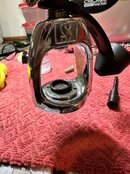Bloody Knuckles
Registered
Timmyjane, If you do a search with the inputs, "MK5" by member "DA Aquamaster" you will see two threads (MK-5 vs. MK10) and (MK5 Questions). Both of these threads are from about 13-14 years ago and contain numerous back and forth comments from DA Aquamaster, Halocline and Awap. Awesome information that will most likely answer any of your questions, and quite a few that you probably didn't have. 
I have three MK5's in various configurations, 2 EA with (2 LP & 1 HP port) and one with the (5 LP port swivel & 2 - 7/16" HP ports). One of the 2 LP port regs has the old "circlip" on the swivel (an interesting design that has been relegated to blowing up beach toys...I use it for kite boarding). Regardless of the configuration, I have personally found the MK5 to be much more forgiving in providing a consistent solid lockup with little to no drift and never any creep...Luck of the draw...IDK). As I'm sure you're aware by now, the piston head and spring are much larger and beefier. I'm not sure if the increased mass of the components helps facilitate this or what? I've always wanted to do a comparison between the MK5 and MK10 in regards to the net resulting sealing force at the knife edge / HP seat interface. I need to find someone with a valve spring tester to determine the K-Value or make up some Rube Goldberg contraption...RSingler???
I have three MK5's in various configurations, 2 EA with (2 LP & 1 HP port) and one with the (5 LP port swivel & 2 - 7/16" HP ports). One of the 2 LP port regs has the old "circlip" on the swivel (an interesting design that has been relegated to blowing up beach toys...I use it for kite boarding). Regardless of the configuration, I have personally found the MK5 to be much more forgiving in providing a consistent solid lockup with little to no drift and never any creep...Luck of the draw...IDK). As I'm sure you're aware by now, the piston head and spring are much larger and beefier. I'm not sure if the increased mass of the components helps facilitate this or what? I've always wanted to do a comparison between the MK5 and MK10 in regards to the net resulting sealing force at the knife edge / HP seat interface. I need to find someone with a valve spring tester to determine the K-Value or make up some Rube Goldberg contraption...RSingler???





